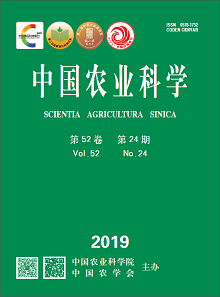【Objective】Through the investigation of 10 major traits in foxtail millet at Ledong, Hainan province, Luoyang, Henan province, Jilin and Gongzhuling, Jilin province, totally four different geographical environments, association analysis between SSR markers and the ten traits was performed to obtain loci expressed in single environment or multiple environments, excavate elite allelic variations, explore the probable mechanism forming ecological adaptation and provide foundation for launching molecular-assistant selection breeding in foxtail millet.【Method】Based on the survey of ten traits (plant height, panicle length, number of leaves, panicle diameter, heading stage, spikelet number, grain number per branch, spike weight, grain weight per panicle and 1000-grain weight) from 102 foxtail millet varieties at Jilin and Gongzhuling, Jilin province, Luoyang, Henan province and Ledong, Hainan province for two consecutive years, correlation analysis of ten traits at each geographical environment was first performed by SPSS 19.0 software, then the 102 foxtail millet varieties were genotyped by 70 polymorphic SSR markers, and further genetic diversity and population genetic structure of these varieties were analyzed. Finally, linkage disequilibrium analysis among markers and association analysis between molecular markers and phenotypic traits were carried out by GLM and MLM models of TASSEL 5.0 software. 【Result】There existed significant or very significant positive correlations among most of the nine agronomic traits except 1000-grain weight across four geographical environments. Only significant or very significant positive correlations were found between 1000-grain weight and grain weight per panicle, plant height, panicle length, spike weight at Jilin, Gongzhuling and Luoyang, no significant correlations were found between 1000-grain weight and other nine traits at Ledong environment. Totally 397 alleles were detected in 70 pairs of SSR primers, giving average observed allele number, effective allele number, expected heterozygosity, Shannon index of 6, 2.24, 0.4637 and 0.7738 per marker respectively. Both genetic diversity analysis and population structure analysis divided 102 foxtail millet materials into 4 groups, and the varieties from Henan province scattered in each of the four groups, showing more abundant genetic diversity. Linkage disequilibrium analysis showed that no obvious LD structures were found among 70 SSR markers. Totally 10 associated markers were detected by GLM and MLM models, combined with allele effect analysis results, it could be determined that b115, MPGC13, b227, b194 and p56 were associated with spike weight, panicle length, number of leaves and heading stage at Jilin, Gongzhuling, sigms9034 and b125 were associated with panicle length and spikelet number at Luoyang, P18 and p59 were associated with spike weight at Ledong, p6 was associated with number of leaves and spikelet number at Jilin, Gongzhuling and Luoyang respectively. The average contribution rates of single marker to phenotypic variation ranged from 7.76% to 34.05%. Three alleles, sigms9034-168, P18-166 and p56-244, could increase panicle length and spike weight, shorten heading stage significantly, which would be used to improve panicle traits and shorten growth period by marker-assisted selection breeding.【Conclusion】Five marker loci (b115, MPGC13, b227, b194 and p56) were steadily detected at Jilin and Gongzhuling, two marker loci (sigms9034, b125), two marker loci (P18, p59) were steadily detected at Luoyang and Ledong respectively for two consecutive years. One marker locus (p6) was steadily detected at Jilin, Gongzhuling and Luoyang, three geographical environments for two consecutive years. Three elite alleles (sigms9034-168bp, P18-166bp, p56-244bp) that could be used to carry out marker-assisted selection for panicle traits and growth period were obtained.









